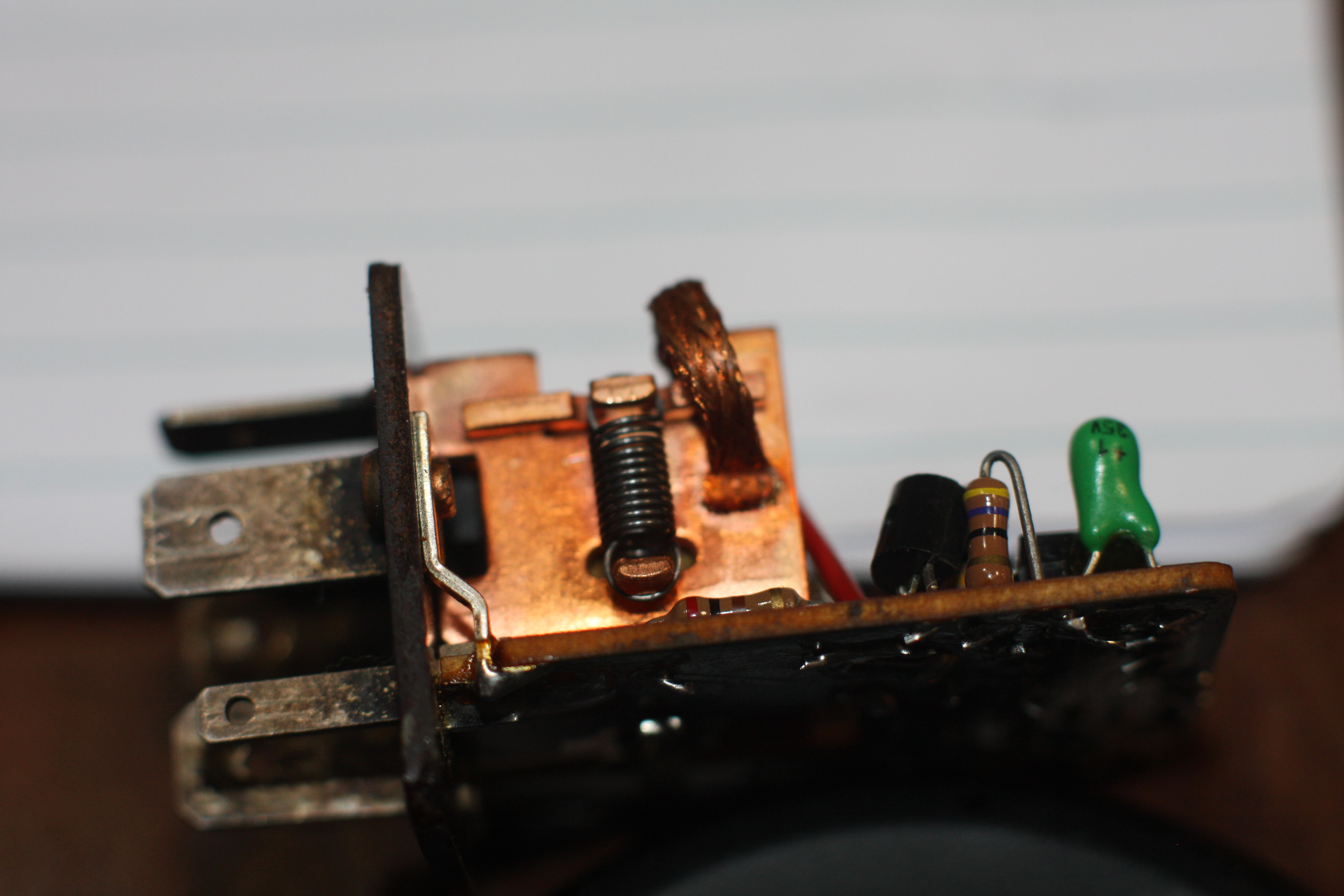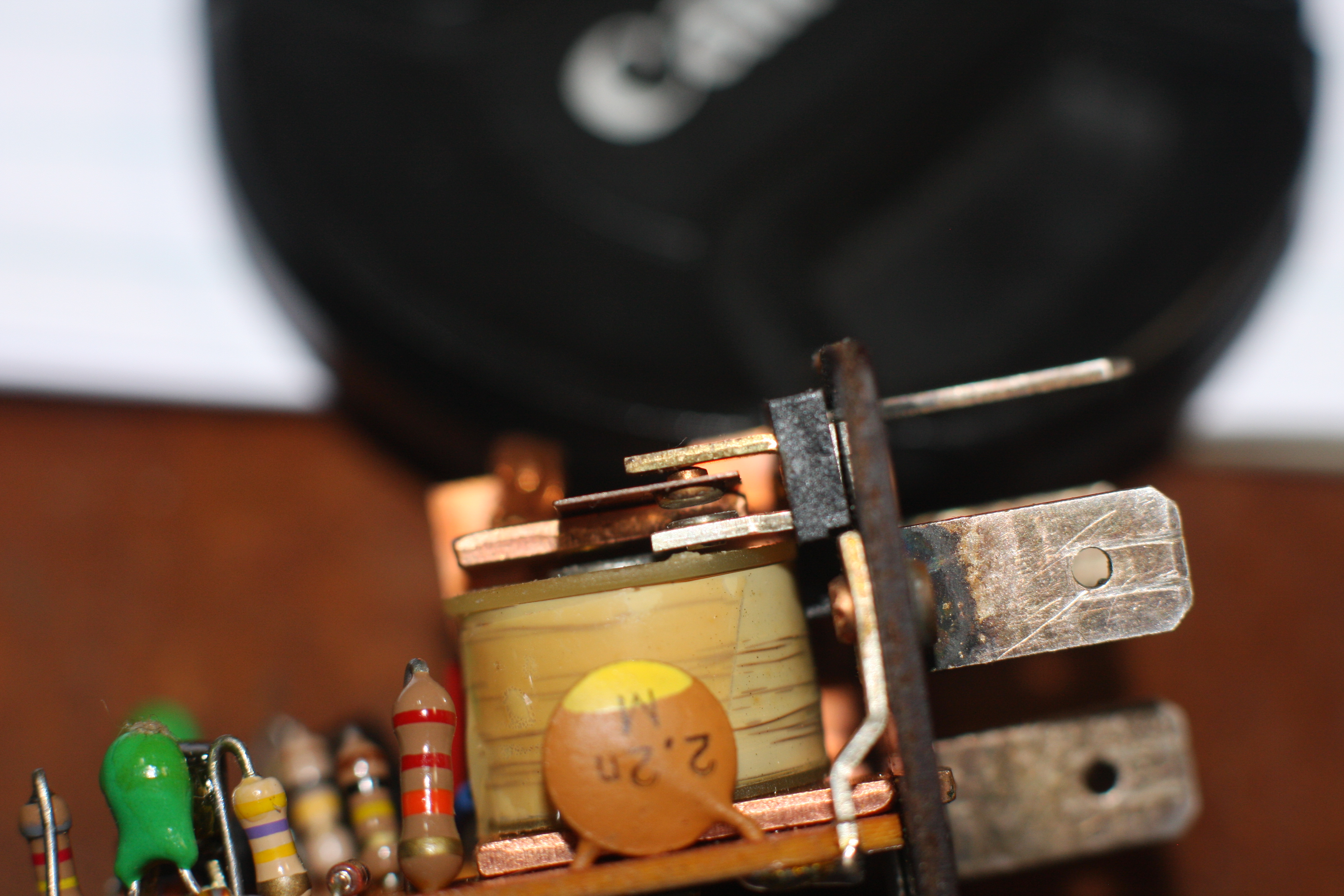Early fuel pump relay insides.
#1
Rennlist Member
Thread Starter
By early I mean the CIS type - 928.615.113.01. Having run out of other distractions, and having 2 old dead relays, I thought nothing to lose from opening them up.Both the same SHO number(SK6468), one dated 5/82, the other 5/93.
My assumption when they died was burnt contacts. Once open you can see on one side a spring holding the moving arm in the points open position. I removed the spring, and was able to get the whole arm out, tethered by the copper braid link. The points arenow easy to access. The old unit (possibly original since the car is an 83) had some erosion of one contact and a deposit on the other, but it was clean and bright, no burning visible, and cleaned up easily with fine wet'n'dry paper. The later unit had a slightly different sprint locating arm, but functionally the same. I believe this unit was the last one I replaced - it died once, then seemed to work again, then died on me again after ~ 20 mins use. Its points were pretty much unmarked and needed no attention. If the contacts are OK, something else must be failing after warming up ? Also curious is that the pins on the old unit have a little surface patina, but the later unit pins have a much darker surface colouring , although both have bright marks where the socket females grip them. I know its pointless to try to re-use these as replacements are available and economic, and for temporary needs jumpering is the way to go, but I just like to know whats going on here.
Spring side. Once the spring is removed the whole arm can be tilted up on the right, and slid out.

Contacts about centre,

jp 83 Euro S AT 57k
My assumption when they died was burnt contacts. Once open you can see on one side a spring holding the moving arm in the points open position. I removed the spring, and was able to get the whole arm out, tethered by the copper braid link. The points arenow easy to access. The old unit (possibly original since the car is an 83) had some erosion of one contact and a deposit on the other, but it was clean and bright, no burning visible, and cleaned up easily with fine wet'n'dry paper. The later unit had a slightly different sprint locating arm, but functionally the same. I believe this unit was the last one I replaced - it died once, then seemed to work again, then died on me again after ~ 20 mins use. Its points were pretty much unmarked and needed no attention. If the contacts are OK, something else must be failing after warming up ? Also curious is that the pins on the old unit have a little surface patina, but the later unit pins have a much darker surface colouring , although both have bright marks where the socket females grip them. I know its pointless to try to re-use these as replacements are available and economic, and for temporary needs jumpering is the way to go, but I just like to know whats going on here.
Spring side. Once the spring is removed the whole arm can be tilted up on the right, and slid out.

Contacts about centre,

jp 83 Euro S AT 57k
#2
Chronic Tool Dropper
Lifetime Rennlist
Member
Lifetime Rennlist
Member
"Premium" relay contacts used to be silver plated, and the same "premium" relays would have had a suppression diode across the contact to kill the arcing that's otherwise inevitable when the relay opens. In your picture you can see the silver pad added to the moving contact, and the little spikes on the stationary contact pad where arcing was moving metal. Over the years and several K-jet and KE-jet cars, I've been tempted to consolidate the timer function on the base, and then add socket terminals so a common 53b relay could piggy-back on there to do the heavy lifting. It just always seemed more expeditious at the time to just buy a replacement.
#3
Nordschleife Master
John - the prime suspect IMO is the transistor (s) (I can see one next to the resistor in your first pic).
Common ones in 928's are BC237 and BC337, but a look with a magnifying glass or a camera on macro mode will confirm the type. You can pick up cheap replacements easily - Jaycar have the aforementioned types, or if there isn't a close one, I've used Futurlec.com a few times too.
Common ones in 928's are BC237 and BC337, but a look with a magnifying glass or a camera on macro mode will confirm the type. You can pick up cheap replacements easily - Jaycar have the aforementioned types, or if there isn't a close one, I've used Futurlec.com a few times too.
#4
Rennlist Member
Thread Starter
That makes sense Hilton. Not really economic to fix these - have a spare on hand anyway. Re Dr Bob's post - When I was young and remarked on some domestic light switches (240V) being much quieter in action than others, I was told these had silver contacts because Silver oxide was a conductor. Researching this now, that doesnt seem to be true, so I am a bit confused as to why it is used. Prolongs the contact life? Doesnt burn like other metals?
jp 83 Euro S AT 57k
jp 83 Euro S AT 57k
#5
Chronic Tool Dropper
Lifetime Rennlist
Member
Lifetime Rennlist
Member
That makes sense Hilton. Not really economic to fix these - have a spare on hand anyway. Re Dr Bob's post - When I was young and remarked on some domestic light switches (240V) being much quieter in action than others, I was told these had silver contacts because Silver oxide was a conductor. Researching this now, that doesnt seem to be true, so I am a bit confused as to why it is used. Prolongs the contact life? Doesnt burn like other metals?
jp 83 Euro S AT 57k
jp 83 Euro S AT 57k
#6
Chronic Tool Dropper
Lifetime Rennlist
Member
Lifetime Rennlist
Member
I will add that using relays with contacts "rated" for greater voltages will help a lot. For instance, industrial relays used in 125 VDC controls have much larger open gaps between contacts. Consider that the current rating on the contacts is related to the size of the contact face and the supporting structure, while the voltage rating is related to how big a gap exists between the contact surfaces when the relay is open. The higher the voltage, the more willing it is to jump a particular gap.
Tangent: When I was searching for a replacement relay in my original AC clutch relay replacement project way back when, I went shopping at an industrial electronics surplus store that happened to be a few blocks from Greg Brown's previous shop in Anaheim. I was shopping specifically for that 125 VDC contact rating to help manage the jolt from the AC clutch coil when the relay opens. This is stupid-geeky stuff, but it was an easy choice at the time, vs. a common 53b style relay with 12 VDC contact ratings/spacing. Looking at the tiny relay inside the early fuel pump relay case, I'd be tempted to make some needle-nose "adjustments" to the stop above the arm, the piece that would be the "B" contact, to increase the contact gap with the relay in the relaxed or de-energized position. Risk is that the relay won't pull in if that gap is too big.
Tangent: When I was searching for a replacement relay in my original AC clutch relay replacement project way back when, I went shopping at an industrial electronics surplus store that happened to be a few blocks from Greg Brown's previous shop in Anaheim. I was shopping specifically for that 125 VDC contact rating to help manage the jolt from the AC clutch coil when the relay opens. This is stupid-geeky stuff, but it was an easy choice at the time, vs. a common 53b style relay with 12 VDC contact ratings/spacing. Looking at the tiny relay inside the early fuel pump relay case, I'd be tempted to make some needle-nose "adjustments" to the stop above the arm, the piece that would be the "B" contact, to increase the contact gap with the relay in the relaxed or de-energized position. Risk is that the relay won't pull in if that gap is too big.


